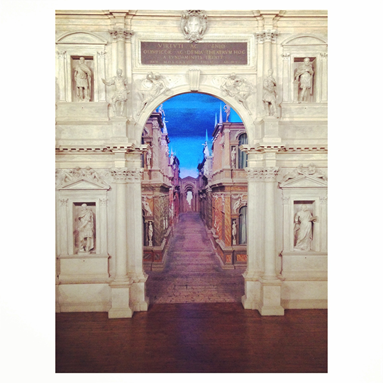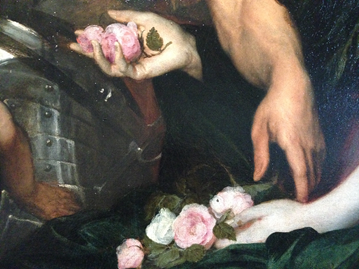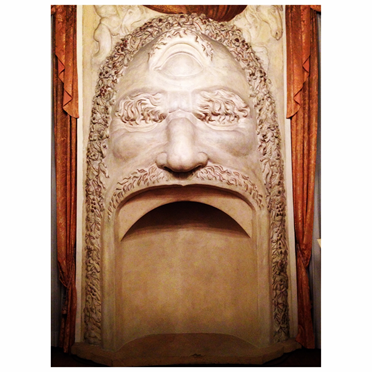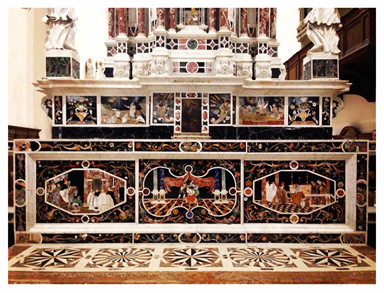One of the greatest things about our ‘Art in Venice and Northern Italy 1100-1600’ class, besides being here in Venice, of course, is that we are able to take class trips to see the art and architecture in person. Most weeks, we have an on-site visit to a church or to see a particular collection of artwork, but we have also taken many out-of-town trips as well. We have been to the islands just north of Venice (Torcello, Murano, and Burano), as well as Padua, and last week we went to Vicenza.
Vicenza is about an hour away on the train. It is still in the Veneto region, just west of Venice. I didn’t really know what to expect from our visit to Vicenza, and was pleasantly surprised. Nicknamed “the city of Palladio,” there is obviously a lot of Palladian architecture, but there is much more to see as well.
We started the day at Palladio’s Teatro Olimpico. The theatre was actually Andrea Palladio’s last project, and was finished after his death. The Teatro Olimpico is the oldest surviving stage set (build in 1580-1585), and is amazing to see in person. It has one large door in the middle of the stage, with two smaller doors flanking it. Through each door, a trompe l’oeil made of paint and stucco gives the impression of a long city street filled with lit up houses and buildings, reaching a perspectival vanishing point in the distance. Palladio brought his knowledge of classical architecture with him to the design of the Teatro Olimpico, specifically the semicircular Roman theatre form.
Across from the Teatro Olimpico is Palladio’s Palazzo Chiericati. The Palazzo Chiericati is a Renaissance palazzo that recalls the suburban villas of antiquity. Inside, the Palazzo houses Vicenza’s art gallery, with works by Paolo Veneziano, Tintoretto, Anthony van Dyck (van Dyck detail in photo below), and Bartolomeo Montagna, among others.
We then walked to the Piazza dei Signori, the administrative centre of Vicenza. The piazza itself is a large rectangular square with the Loggia del Capitanio (the seat of the administration, where the city council now works) on one side and the Basilica Palladiana (also known as the Palazzo della Regione, which houses offices on its upper level and a loggia with shops on the bottom), both designed by Palladio. The Basilica Palladiana is also where we stopped for lunch.
After lunch, we walked to Palladio’s Palazzo Thiene (http://www.palazzothiene.it), which, like the Palazzo Chiericati, we were able to take a look around inside. The palazzo was bought by the Banca Popolare of Vicenza in 1872, and houses a portion of the bank’s impressive collection inside. We were very lucky to have a guided tour and were able to see some truly amazing rooms and decorations. Among my favourites were the Cyclops fireplace in the Sala di Nettuno and the nineteenth century plate collection from the Veneto region.
Finally, we visited Santa Corona, where Palladio was buried. However, the purpose of our trip to this church was not Palladio-based, for once, but rather to see Giovanni Bellini’s Baptism of Christ (1500-1502), which relates to the topic of the evolution of the altarpiece that we have been discussing in our lectures. The high altar in Santa Corona was what I was most taken with. The inlaid marblework is amazing, with mother of pearl, coral, lapis lazuli, and jasper with a black stone background, and features biblical scenes as well as decorative elements such as villages, animals, plants, and fruits.
Our last stop of the day was the Church of San Lorenzo, which we visited mainly to see its façade and its portal lunette. The lunette was sculpted by Andriolo de Santi, and features the Virgin and Child flanked by Saints Lawrence and Francis (San Lorenzo is a Franciscan church), as well as a kneeling (or standing) patron, Pietro da Marano (also known as Il Nano, or the dwarf).

(this image was taken from Google images)
There is much to see and do in Vicenza. In fact, we are going back in a couple of weeks to visit the Palladian Villas in the area. If you ever have the chance, I would recommend taking a day trip and looking around the area.





